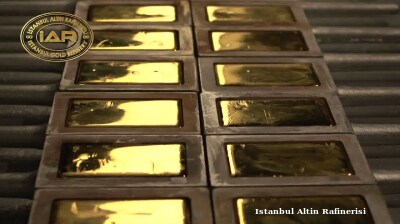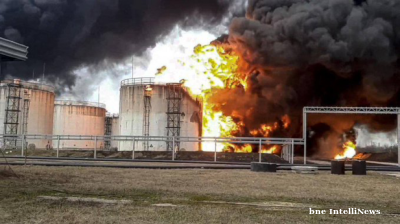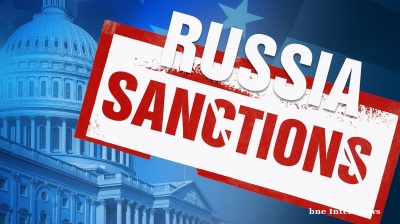Russia's ability to sustain export flows of vital commodities has helped the Kremlin withstand Western sanctions imposed following the invasion of Ukraine. However, S&P Global warns that the health of its critical oil and gas sector is deteriorating under these pressures.
Sanctions have significantly limited Russia's access to global financial markets and essential Western technologies, driving up production costs and increasing the likelihood of operational disruptions.
However, the federal budget remains in good shape, thanks to the reorientation of oil exports from Europe to Asia and the sustained higher prices thanks to OPEC production cuts.
“The Russian economy has so-far proven to be relatively resilient to these factors though, for three main reasons. Firstly, supply risks linked to the conflict led to commodities prices skyrocketing in the immediate aftermath of the war, boosting Russian revenues. Secondly Russia was able to redirect large volumes that were previously shipped West to non-sanctioning markets, including India and China. Finally, Russia is able to capitalise on the ruble to dollar exchange rate to ensure that if its dollar revenues decline, it can meet its ruble-denominated domestic costs,” S&P Global says.
But more recently the Central Bank of Russia (CBR) has started to worry that the military Keynesianism factors that have boosted growth are exhausted and the economy is already starting to cool. High inflation has also forced the CBR to hike the prime rate to 18% which is also crushing growth.
These effects are likely to take a few years to make themselves left; GDP growth this year is expected to be in the range 3.4% to 3.8% on a par, or faster, than the 3.6% recorded in 2023. Russia’s federal budget deficit fell to $10.6bn, or half a percent of GDP, below the projected 0.8% forecast, in the first half of this year. The deficit is on course to hit its target, which will be half the size of the 1.9% deficit in 2023.
At the same time, Russia’s current account surplus in June 2024 was $4.7bn against $6.3bn in May 2024 and $40.6bn for the first half of this year, up from $23.3bn in the corresponding period of 2023. That puts Russia on track to earn some $90bn as a current account surplus for the full year in 2024, ahead of the $51bn it earned in 2023 – almost double, but still well behind the all-time record $230bn it earned in the first year of the war in 2022. This year’s current account surplus will also be less than the previous pre-war all-time record high of $120bn earned in 2021.
Mounting fiscal pressures
But the situation is expected to worsen over time, says S&P Global. “While Russia is currently managing these problems, they are likely to become more damaging with time. Russia's fiscal breakeven oil price has increased significantly since it invaded Ukraine, as it incurs major costs related to the conflict. S&P Global Commodity Insights estimated Russia's fiscal breakeven oil price at $62 per barrel in 2021, rising to $120/bbl in 2022, $103/bbl in 2023 and $94/bbl for 2024,” S&P Global said in a note.
Impact on oil and gas revenues
Oil and gas sales remain the cornerstone of Russia’s revenue streams. In 2023, these revenues amounted to RUB8.822 trillion ($87.6bn), slightly down from RUB9.057 trillion in 2021. The peak in 2022 at RUB11.586 trillion was driven by extreme volatility in commodity prices. However, sanctions have imposed significant discounts on Russian crude. The Urals grade, for example, traded at a discount of over $40 per barrel to Dated Brent in April 2022, though this gap has since narrowed to $11.9 per barrel as of August 7.
"Russia still has a comfortable level of hydrocarbon revenues, but sanctions pressure step by step starts to squeeze the Russian budget and corporate revenues. Russia is working hard to find ways to increase its revenues; a lot will depend on the consistency of sanctions implementation and control," S&P Global said.
The sustainability of these revenues will depend heavily on the continued enforcement of sanctions.
Russia’s federal budget revenues from the oil and gas sector climbed by 68.5% in January-June year on year to RUB5.7 trillion ($64.8bn), the Finance Ministry reports. And Russia's oil and gas revenues grew by more than 50% over the first half of this year, faster than expenditures, which were up by about a quarter over the same period, as OPEC restrictions push up the prices.
Challenges in gas exports
Russia has faced greater difficulties in maintaining gas revenues compared to oil. Revenues for the national gas champion Gazprom have collapsed and it recently posted its first loss in 25 years of $6.9bn. The company’s business will take at least a decade to recover, says Gazprom.
By contrast, Russian LNG supplies to Europe have been booming, totalling 17bn cubic metres in 2023, up from 13.5 bcm in 2021. The latest EU sanctions include restrictions on re-exports of Russian LNG landed at EU ports to markets elsewhere and sanctions against Russian LNG projects under development, which could dent these flows.
The EU aims to fully phase out Russian oil and gas imports by 2027.
Although gas exports to China have risen, redirecting gas supplies from Europe is more complex, as most of Russia’s pipeline network runs west; an eastern looking pipeline network was never developed other than the Power of Siberia 1 and Eastern Siberia-Pacific Ocean (ESPO) pipelines, both of which go to China.
That work has begun now. The planned Power of Siberia 2 pipeline to China, which would pass through Mongolia, remains under negotiation.
Additionally, Russian LNG exports to Europe have climbed, but EU sanctions on re-exports and new Russian LNG projects could threaten these flows. The EU aims to eliminate Russian oil and gas imports by 2027.
Non-energy revenue streams
Beyond hydrocarbons, Russia continues to earn significant revenues from other exports to the EU, such as food, fertilisers and metals, some of which are harder to sanction.
For instance, EU imports of Russian cereals and oilseeds, as well as nuclear fuel, have increased since 2021, reflecting ongoing dependencies that complicate the sanctions landscape.
As bne IntelliNews reported, Russia remains a major exporter of fertilisers which have not been sanctioned. Exports of potash were up 70% year on year in the first half of this year, with a large share going to Europe.
Potash fertiliser exports from Russia surged in the first half of this year, reaching 6.7mn tonnes, a 1.7-fold increase compared to the same period last year, according to data from the Metals & Mining Intelligence (MMI) agency – the strongest growth in six months.
And Russia has more than doubled its agricultural exports over the past decade, despite the Kremlin’s tit-for-tat ban on food trade with the EU that was imposed in 2014 after the annexation of Crimea, according to the Russian Ministry of Agriculture.
The West also remains addicted to Russian enriched uranium exports, a business Russia dominates. Uranium is the new gas as Moscow is using its nuclear power technology to bind partner countries to it with energy security bonds. Several countries in the EU, particularly in eastern Europe and Finland, operate Russian-made VVER reactors and remain dependent on Russian uranium imports. The US has also “banned” Russian uranium imports, but as it also remains heavily dependent on Russia for nuclear fuel, this ban comes with a system of waivers that will run until 2028, when the US hopes to have developed domestic supplies of uranium. In the meantime, EU imports of nuclear fuel expanded from 260 tonnes in 2021 to 570 tonnes in 2023.
Metal exports have done less well, as they have been the subject of sanctions, but Europe continues to import significant amounts of Russian metals. In 2023, the EU imported 5.8mn tonnes of iron and steel products from Russia, down from 10.9mn tonnes in 2021, according to S&P Global.
“Current volumes mostly comprise unrolled steel, pig iron and sponge iron imports, although they are limited by quotas,” the agency says.
Increasingly isolated, Russian metals producers have turned to China, which has gone from being a primary competitor to a principal client. The EU’s fourteenth sanctions package adopted in April included bans on imports of Russian aluminium, copper and nickel, all critical inputs for producing a wide range of goods from drinks cans to semiconductors and electric vehicles (EVs).
Arms are another major export product and the picture here is mixed. Orders for Russian weapons from foreign countries have risen to over $60bn since 2022, according to Dmitry Shugaev, the director of the Federal Service for Military-Technical Cooperation (FSVTS).
However, the war in Ukraine has not been without effect. Data from the Stockholm International Peace Research Institute (SIPRI) published in March 2024 indicates that Russian arms exports in 2019-2023 fell by 53% compared to the previous five-year period of 2014-2018.
This decline saw Russia fall to third place globally in arms exports for the first time after France and the US. The fall may be partly due to the fact that Russia is using all its arms in the war and has less surplus to export. Russia's share of the global arms market currently stands at 11%, behind France, which saw a 47% increase in exports and also holds an 11% share of the global market, and the United States, which leads with a 42% share after a 17% increase in 2023.

Russia remains heavily dependent on commodity exports, says S&P Global
Features

BEYOND THE BOSPORUS: Prosecutors make move on “fictitious export schemes” of Istanbul Gold Refinery
Observers point to intra-regime gangs seizing each other’s wealth, remember Erdogan’s “Hello Fatih” phone calls and ponder whether wanted man Turgay Ciner is in London.

Taliban visit to India upsets Pakistan, signals New Delhi's changing Afghan posture
Coinciding with the visit, Pakistan conducted military operations inside Afghanistan, followed by airstrikes on multiple border towns. Retaliation against Pakistan's police training facilities and border outposts followed.

Pakistan’s India-shaped chip on the shoulder, and why a peaceful coexistence is as elusive as ever
Pakistan must first redefine how it sees India - not solely as a threat to be contained but as a neighbour with whom coexistence is unavoidable. That psychological leap has eluded generations of Pakistani leaders.

Trump shocked by China’s move on rare earths, threatens more 100% tariffs
"Some very strange things are happening in China!" Trump wrote in a post on his Truth Social account on October 10, adding "They are becoming very hostile."




